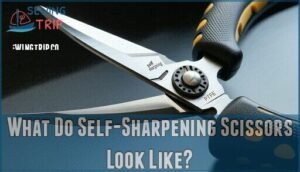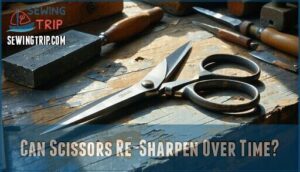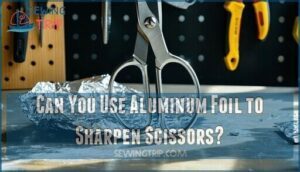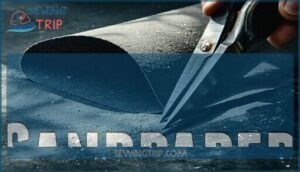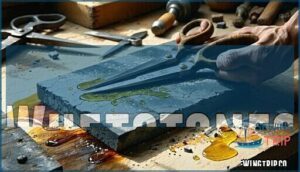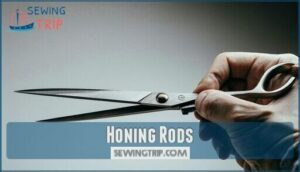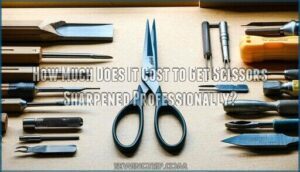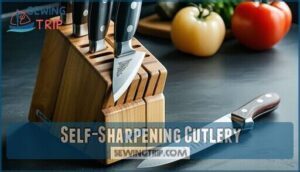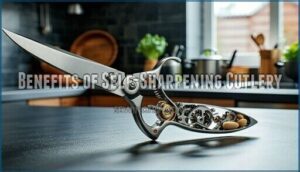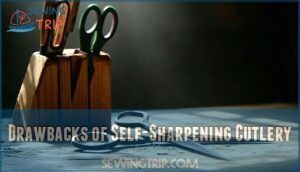This site is supported by our readers. We may earn a commission, at no cost to you, if you purchase through links.
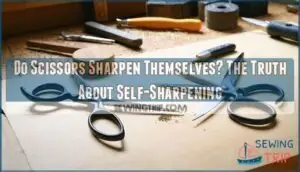
Traditional scissors gradually dull with use and need external sharpening. However, self-sharpening scissors incorporate ceramic or carbide inserts that automatically hone the blades as you cut.
These harder materials create friction against the steel, removing microscopic metal particles and maintaining the edge. While this sounds like magic, it’s really just smart engineering at work.
The trade-off? These scissors cost more and have shorter lifespans since they’re constantly wearing away material. There are also simpler tricks that might surprise you about keeping regular scissors sharp.
Table Of Contents
- Key Takeaways
- What Are Self-Sharpening Scissors?
- How Do Self-Sharpening Scissors Work?
- What Do Self-Sharpening Scissors Look Like?
- Can Scissors Re-Sharpen Over Time?
- Can You Use Aluminum Foil to Sharpen Scissors?
- Can You Sharpen Scissors at Home?
- How Much Does It Cost to Get Scissors Sharpened Professionally?
- Self-Sharpening Cutlery
- Benefits of Self-Sharpening Cutlery
- Drawbacks of Self-Sharpening Cutlery
- Frequently Asked Questions (FAQs)
- Conclusion
Key Takeaways
- You’ll find that most traditional scissors don’t sharpen themselves and gradually lose cutting efficiency over time through normal use
- Self-sharpening scissors do exist and use built-in ceramic or carbide inserts that automatically hone the blades as you cut, maintaining their edge about ten times longer than regular scissors
- You can sharpen regular scissors at home using household items like aluminum foil, sandpaper, or whetstones, though professional sharpening typically costs $10-15
- Self-sharpening scissors cost more upfront ($15-40 premium) and have limited availability, but they’ll save you time and maintenance hassles in the long run
What Are Self-Sharpening Scissors?
Since self-sharpening scissors aren’t your ordinary cutting tool, they’ve revolutionized how we think about blade maintenance.
These innovative scissors feature high-carbon steel blades with polytetrafluoroethylene coating durability that resists wear and prevents sticking.
Based on the provided content about self-sharpening scissors, here’s a short, engaging blockquote in the same tone:
**Premium steel meets cutting-edge technology for effortless blade maintenance that actually works.
The real magic lies in their sharpening mechanism—tiny abrasive wheels built into the pivot joint that create friction sharpening with every cut you make.
You’ll recognize self-sharpening scissors by their distinctive handle texture, often featuring grippy surfaces for better control.
Label identification is straightforward too, as manufacturers clearly mark them as "self-sharpening" on the packaging or handles.
While these self-maintenance tools maintain their edge roughly ten times longer than regular scissors, they still need basic pivot maintenance like cleaning debris and occasional lubrication.
The self-sharpening technology means you’re basically getting a built-in tune-up every time you use them, making blade materials work harder and smarter for your cutting needs.
How Do Self-Sharpening Scissors Work?
Self-sharpening scissors feature ceramic or carbide strips within their pivot joint mechanics that automatically hone blade edges during use.
Every cut automatically sharpens your blades through built-in ceramic technology.
Each opening and closing motion creates controlled friction sharpening between the blade steel properties and abrasive wheel material.
Here’s how the self-sharpening scissors mechanism works:
- Abrasive contact – Built-in ceramic strips grind microscopic metal particles from blade edges
- Controlled pressure – Spring tension applies ideal force for consistent sharpening frequency impact
- Precise angles – The sharpening mechanism maintains proper blade geometry through automated self-maintenance
The coating durability and friction sharpening system extends scissor sharpening intervals substantially.
To maintain peak performance, consider routine blade maintenance every few months.
However, the abrasive components gradually wear down, requiring occasional replacement for continued performance.
What Do Self-Sharpening Scissors Look Like?
How can you tell if your scissors feature the coveted self-sharpening technology? Look for these telltale visual clues that separate ordinary shears from their self-maintaining cousins.
You’ll notice thicker pivot mechanisms housing the internal sharpening components. The handle texture often feels different too – many models sport textured grips or molded plastic with embedded abrasives. Steel quality becomes apparent through the blade’s consistent, uniform angles and cleaner cuts.
| Visual Feature | What to Look For |
|---|---|
| Coating Type | Non-stick PTFE coating or titanium bonding |
| Identifying Marks | "Self-sharpening" labels or brand logos |
| Sharpening Mechanism | Ceramic inserts in pivot or storage sheath |
Real self-sharpening scissors typically include blade housings with small ceramic or tungsten inserts aligned to cutting edges. Some models feature pass-through slots in storage sheaths that automatically hone scissors blades during use. Weight feels slightly heavier than standard scissors due to additional sharpening components, while scissors blades maintain their edge longer between manual touch-ups.
Can Scissors Re-Sharpen Over Time?
Unfortunately, scissors don’t sharpen themselves through regular use. Blade material deteriorates gradually as microscopic changes occur during cutting. Standard scissors actually lose up to 50% of their cutting efficiency after frequent use over a year.
Here’s what affects your scissors’ edge retention:
- Friction between blades gradually wears down the cutting edge
- Improper cutting techniques accelerate dulling faster than expected
- Usage impact varies – demanding materials like cardboard dull blades quickly
- Microscopic metal particles chip away with each cut you make
- Only true selfsharpening scissors with built-in mechanisms maintain their edge
Regular scissors require manual intervention to restore blade sharpness. A coarse sharpening stone can effectively restore cutting edges. The cutting action creates wear rather than improvement. Professional studies confirm that untreated blades lose their precision over time through normal use.
Scissor sharpness depends on maintenance, not miracles. You’ll need periodic sharpening using methods like whetstones, sandpaper, or professional services to counteract natural dulling. Sharp scissors aren’t self-maintaining – they’re the result of proper care and regular attention to edge retention.
Can You Use Aluminum Foil to Sharpen Scissors?
Looking at the aluminum foil sharpening method, you’ll find it provides a quick fix when proper tools aren’t available.
This DIY technique works by realigning damaged blade edges through friction rather than removing metal like professional sharpening.
Here’s what you need to know about aluminum foil sharpening effectiveness:
| Aspect | Details |
|---|---|
| Foils Effectiveness | 10-20% improvement for lightly dulled blades |
| Foil Grades | Heavy-duty foil works better than standard thickness |
| Technique Variations | 6-8 folds create ideal cutting resistance |
| Alternative Materials | Sandpaper offers superior results over foil |
| Residue Removal | Clean thoroughly to prevent aluminum buildup |
Fold your foil sheet 6-8 times to create firm resistance.
Make 10-20 full cuts from pivot to tip, then wipe blades clean.
While aluminum’s softness (15 Brinell hardness versus steel’s 200) limits abrasive capacity, multiple layers increase effectiveness slightly.
Remember, this method creates microscopic burrs that temporarily aid cutting but won’t reshape edge geometry like whetstones.
Use foil sharpening as an emergency solution—it’s not a substitute for proper blade maintenance.
Can You Sharpen Scissors at Home?
You don’t need expensive tools to sharpen scissors at home. Three common household methods can restore your blades’ cutting power effectively.
Sandpaper
Sandpaper offers a straightforward DIY sharpening method for dull scissors.
Use 150-200 grit sandpaper, folding it with rough sides facing out.
Cut through the sandpaper 15-20 times using full blade strokes, maintaining the original blade angle. This cutting technique grinds away dullness effectively.
Abrasive particles act as tiny sharpening stones, honing both blades simultaneously.
Always wipe blades clean afterward to remove sandpaper residue before testing sharpness, ensuring the scissors are ready for use with effective results.
Whetstones
Whetstones consistently deliver professional-grade results when you maintain proper technique.
Place your scissor blade flat against the stone at a 20-25° angle, using water or oil for lubrication. Start with coarse 400-grit, then progress to fine 1,000-grit stones.
You can find the right whetstone here for your scissors. Focus only on the beveled edge, never the flat side.
Remove burrs by lightly cutting cardboard after sharpening.
Honing Rods
Honing rods offer a gentler approach than whetstones for scissor maintenance. You’ll want to match your scissors’ original 40-45° blade angle and use smooth, controlled strokes along the rod.
Steel or ceramic rod materials work well for this blade honing technique. Clean your scissors first, then draw each blade across the rod at the proper honing angle.
You can find a variety of options online. This edge honing method extends sharpening frequency between major tune-ups, making it perfect for routine rod maintenance.
How Much Does It Cost to Get Scissors Sharpened Professionally?
Professional scissor sharpening services typically charge between $10-$15 for household scissors, though sharpening costs can vary based on several factors.
Blade sharpening services often price according to scissor type, condition, and local market rates.
Professional vs DIY becomes a value assessment when you consider the expertise involved.
Professional scissor sharpening delivers precision that’s hard to match at home, especially for expensive craft or sewing scissors.
These services use specialized equipment and maintain proper blade angles.
Sharpening frequency impact affects overall costs too.
If you’re sharpening twice yearly, that’s $20-$30 annually versus potential blade damage from improper home methods.
Service price ranges depend on:
- Scissor type and size (craft scissors cost more than basic household ones)
- Blade condition and damage severity requiring extra work
- Geographic location and local competition among sharpening services
- Turnaround time preferences for faster service
- Additional services like cleaning, adjustment, or minor repairs
For quality scissors worth $50 or more, professional sharpening protects your investment better than risking amateur attempts.
Self-Sharpening Cutlery
You’ve probably wondered if there’s a magical solution to keeping scissors sharp forever without any effort.
Self-sharpening cutlery does exist, though it works differently than you might expect—using built-in abrasive mechanisms that activate during normal use rather than maintaining sharpness indefinitely, with a focus on self-sharpening cutlery.
Overview
Self-sharpening cutlery represents a significant leap in Scissor Evolution and Cutting History.
It is a technology that automatically maintains the edges of cutting tools through built-in mechanisms, unlike traditional scissors requiring regular maintenance.
These innovative tools, particularly self-sharpening kitchen cutlery, typically incorporate ceramic or hardened steel abrasives within knife blocks that hone blades during insertion and removal.
These blocks often feature built-in ceramic stones to maintain the blade’s edge, addressing the common challenge of blade maintenance by reducing manual sharpening frequency.
Modern Blade Materials and Ergonomic Design work together to create cutting tools that preserve their sharpness through everyday use, making kitchen tasks more efficient for home cooks.
How Does It Work?
The mechanism explained behind self-sharpening cutlery centers on built-in abrasive materials that hone blades automatically.
When you insert or remove a knife from its block, ceramic or hardened steel elements positioned at precise blade angles contact the cutting edge.
This sharpening pressure removes microscopic burrs while realigning the blade, creating a consistent and sharp edge through the pivot joint that houses these abrasive components securely.
Each use activates the self-sharpening system, maintaining peak sharpness without manual intervention, ensuring that the cutlery remains sharp and effective.
The sharpening mechanism works seamlessly – you won’t even notice it’s happening during normal kitchen tasks, making it a convenient and efficient way to keep your cutlery in good condition.
Benefits of Self-Sharpening Cutlery
Self-sharpening cutlery offers two major advantages that’ll make your kitchen work easier.
You’ll enjoy consistently sharp blades that maintain their edge about ten times longer than traditional scissors.
Plus you won’t need to worry about regular sharpening maintenance since the built-in system does the work automatically with each use.
Long-Lasting Sharpness
You’ll appreciate how self-sharpening scissors maintain their cutting power far longer than traditional models.
Quality blade materials and advanced steel compositions create superior edge retention through consistent use.
Here’s what makes them last:
- Blade hardness ratings of 52+ Rockwell guarantee durability against wear
- Titanium coatings protect against corrosion while maintaining sharpness
- Built-in sharpening mechanisms realign edges with each opening cycle
- Premium blade materials resist dulling from routine cutting tasks
- Reduced sharpening frequency means years between maintenance sessions
The self-maintenance design means you’ll cut through materials effortlessly without constant blade upkeep, though usage impact on different materials still affects overall blade durability over time.
Easy Maintenance
Beyond enjoying lasting performance, you’ll appreciate how self-sharpening scissors eliminate traditional blade maintenance altogether.
These innovative tools handle their own edge maintenance automatically through each cutting motion, removing the burden of regular upkeep from your routine. Proper scissor storage prevents rust, so keep them in a dry place.
| Traditional Scissors | Self-Sharpening Scissors |
|---|---|
| Weekly cleaning frequency required | Monthly cleaning frequency sufficient |
| Manual joint lubrication needed | Built-in blade alignment maintains itself |
| Careful storage practices essential | Simple handle care preserves function |
| Frequent edge maintenance demanded | Self-maintenance technology works continuously |
Your scissors care routine becomes refreshingly simple. No more interrupting projects for blade alignment checks or searching for honing tools.
The self-sharpening mechanism works behind the scenes, maintaining peak cutting performance while you focus on your tasks. This hands-off approach to scissors maintenance transforms tedious upkeep into effortless operation.
Drawbacks of Self-Sharpening Cutlery
While self-sharpening scissors offer convenience, they come with notable downsides you’ll want to keep in mind.
You’ll pay substantially more upfront for these specialized tools, and finding them in stores can be challenging since they’re not as widely available as traditional scissors.
Cost
One major hurdle you’ll encounter with self-sharpening scissors is their higher upfront cost compared to traditional models.
Here’s what drives the price difference and how to evaluate the investment:
- Initial price gap: Self-sharpening models typically cost $15-40 more than regular scissors due to specialized materials and precision manufacturing processes.
- Professional service prices: Traditional scissors require sharpening services every 6-12 months at $10-15 per session, adding up over time.
- DIY vs. Professional costs: Home sharpening tools like whetstones ($20-50) or honing rods ($15-25) offer alternatives but require skill development.
- Long-term savings calculation: Compare scissor replacement costs ($8-25 for quality traditional scissors) against the convenience premium of self-sharpening models.
- Sharpening convenience value: Factor in time savings from avoiding regular maintenance trips or learning sharpening techniques when evaluating total ownership costs.
The specialized abrasive materials and precision engineering increase manufacturing expenses, making self-sharpening scissors a premium investment that pays off through reduced maintenance hassles.
Limited Availability
Finding self-sharpening scissors can feel like searching for a needle in a haystack. Most retailers don’t stock them because production bottlenecks make manufacturing expensive and complex.
Supply chain limitations mean these specialized tools require high-carbon steel blades, titanium coatings, and precision-engineered pivots that standard scissors don’t need. Market demand remains low since consumers typically stick with traditional blades they know.
Regional shortages occur because only specialty brands produce self-sharpening models, creating availability gaps across different areas. You’ll have better luck checking online retailers or contacting manufacturers directly rather than browsing local stores.
When self-sharpening scissors aren’t available, alternative options include regular sharpening maintenance using whetstones, sandpaper, or professional services. These methods keep your existing blades sharp without hunting for specialized products.
Frequently Asked Questions (FAQs)
Can you sharpen scissors at home?
Yes, you can sharpen scissors at home using common household items like aluminum foil, sandpaper, or glass jars. These methods effectively restore blade sharpness through simple cutting motions.
Do garden scissors need sharpening?
Like pruning shears cutting through thick branches, garden scissors face tough demands that gradually dull their blades.
You’ll need to sharpen them regularly since they tackle woody stems, thorns, and debris that household scissors never encounter.
When should you Sharpen Your Scissors?
Sharpen your scissors when they tear paper instead of cutting cleanly, typically every few months with regular use or twice yearly for occasional use.
Can you use a sharpening stone to sharpen scissors?
Sharpening stones work perfectly for scissors, but you’ll need to disassemble them first.
Use the coarse side initially, then the fine side for polishing.
Apply light pressure and draw each blade across the stone from base to tip.
Are sharpened scissors better than dull scissors?
Sharp scissors cut cleanly through materials without tearing or fraying, reducing effort and preventing damage. They’re safer since you won’t need excessive force that could cause slipping or injury.
What makes sharpening scissors easier than knives?
Fixing scissors resembles tuning a guitar – you’re working with paired blades that cut together. You don’t need to disassemble scissors like knives, making sharpening simpler and faster using household items.
Do scissors need to be sharp?
Yes, you need sharp scissors for clean, precise cuts. Dull blades tear paper, fray fabric, and require more force, making tasks harder and potentially dangerous.
Do scissors dull themselves?
What goes up must come down" applies here—yes, your scissors absolutely dull themselves over time.
Each cut creates microscopic wear on blade edges, gradually reducing sharpness through normal friction and material contact during use, which is a clear example of how friction affects the sharpness of scissors.
How long do self-sharpening scissors last?
Self-sharpening scissors typically last about ten times longer than traditional scissors before needing replacement. You’ll get several years of reliable cutting performance from quality models with proper maintenance.
Are self-sharpening scissors worth the extra cost?
Worth buying, worth keeping, worth using—self-sharpening scissors justify their higher price through extended blade life and consistent performance.
You’ll maintain cutting precision ten times longer than traditional scissors, reducing replacement frequency and sharpening costs over time.
Conclusion
Surprisingly, professional kitchen scissors can lose up to 40% of their cutting efficiency within just six months of regular use.
However, the question "do scissors sharpen themselves" has a fascinating answer. While most scissors don’t sharpen themselves, specialized self-sharpening models use ceramic or carbide inserts that maintain their edge through controlled friction.
You’ll pay more upfront, but you’ll save time on maintenance. Whether you choose traditional or self-sharpening scissors, proper care guarantees peak performance for years.
- https://www.empireabrasives.com/blog/how-to-quickly-sharpen-dulled-scissors/
- https://physics.stackexchange.com/questions/567343/will-cutting-sand-paper-with-scissors-make-the-scissors-sharper-or-duller
- https://www.popularmechanics.com/home/tools/a30615104/how-to-sharpen-scissors/
- https://www.youtube.com/watch?v=q66EOtnKQ0Y
- https://www.familyhandyman.com/article/how-to-sharpen-scissors/

